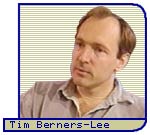 |
|||
 |
|||
![]() Spinning the
Web
Spinning the
Web
In 1990,
Tim Berners-Lee, a computer programmer at
CERN in Switzerland, began working on a way to provide access to research
materials to everyone over the network.
 CERN had an international mix
of researchers and a diverse collection of computers and operating
systems. Reformating documents for each computer platform every time
their content changed would require too much time and money.
CERN had an international mix
of researchers and a diverse collection of computers and operating
systems. Reformating documents for each computer platform every time
their content changed would require too much time and money.
While Berners-Lee was grappling with this problem, Mike Sendall, a fellow computer programmer at CERN, purchased a new NeXT workstation for evaluation. When he decided not to use it, he offered it to Berners-Lee. Berners-Lee was impressed with the NeXT cube's object-oriented operating system and it gave him an idea for a solution to the problem of distribution.
During the next year Berners-Lee worked on a system including a server to store documents and a client to request documents from the server. He finished the first working "browser" and server in 1991, but it was very primitive and displayed only text. At the time, all Berners-Lee wanted was a way for researchers to access text-based documents - nothing more. Others wanted more.
Copyright © 1998, PBS Online,
Inc. All Rights Reserved.
Site Designed and Developed by
OPB Learning Media